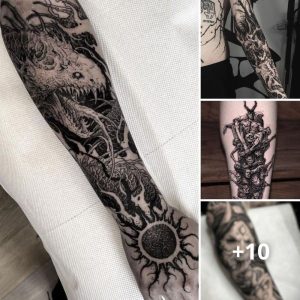
One of the most intriguing realms within the world of tattoos is the biomechanical genre. Originating in the early 1980s, biomechanical tattoos have steadily gained popularity for their unique blend of artistic expression and mechanical aesthetics. This fascinating tattoo style captivates enthusiasts with its intricate designs that mimic the inner workings of machinery, creating a harmonious fusion of nature and technology.
History of Biomechanical Tattoos:
The emergence of biomechanical tattoos can be traced back to the visionary creativity of tattoo artists inspired by science fiction and cyberpunk themes. During the 80s, a surge of interest in futuristic concepts and the integration of man and machine fueled the growth of biomechanical tattooing. Pioneering artists like H.R. Giger, known for his work on the movie Alien, played a pivotal role in shaping the biomechanical tattoo movement.
Characteristics of Biomechanical Tattoos:
Biomechanical tattoos stand out for their distinctive features, incorporating elements that mimic machinery, robotics, and cybernetics. Intricate gears, pistons, cables, and circuitry are seamlessly integrated into the design, giving the illusion that the wearer’s body is a complex machine beneath the skin. This genre often includes elements like biomechanical animals, creating a surreal and visually striking effect.

Symbolism and Meaning:
While biomechanical tattoos may seem purely aesthetic, they often carry profound symbolism. The fusion of organic and mechanical elements represents the duality of nature and technology. It reflects the interconnectedness of humanity with the evolving world of machines, portraying a harmonious coexistence. Additionally, these tattoos can symbolize resilience and adaptability, emphasizing the strength and durability of both man and machine.
The Artistic Process:
Creating a biomechanical tattoo requires a skilled artist with a deep understanding of anatomy, machinery, and artistic principles. The design process involves careful consideration of the body’s contours to create a seamless integration of mechanical elements. Artists use shading and detailing techniques to add depth, creating a three-dimensional effect that enhances the realism of the biomechanical design.

Popular Themes and Variations:
Within the biomechanical tattoo genre, several themes and variations have emerged. Biomechanical sleeves, where the entire arm is transformed into a complex machine, are particularly popular. Other variations include biomechanical insects, depicting robotic adaptations of natural creatures. The versatility of this tattoo style allows for endless creativity, making it a preferred choice for those seeking personalized and unique body art.
Choosing the Right Artist:
Given the complexity of biomechanical tattoos, selecting the right artist is crucial. Look for tattooists with a proven track record in biomechanical designs, as well as a portfolio showcasing their technical skills and creativity. Discuss your ideas with the artist, ensuring a collaborative approach that brings your vision to life while leveraging the artist’s expertise.

In the world of tattoos, biomechanical art stands as a testament to the boundless creativity and innovation within the industry. Combining the organic beauty of the human body with the precision of machinery, biomechanical tattoos offer a visually captivating and symbolically rich form of self-expression. As this unique tattoo style continues to evolve, it remains a timeless choice for those seeking a blend of artistry and the mechanical marvels of our ever-advancing world.






